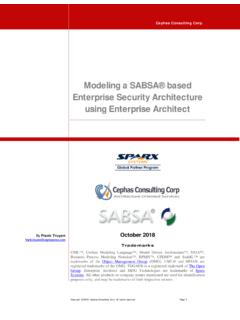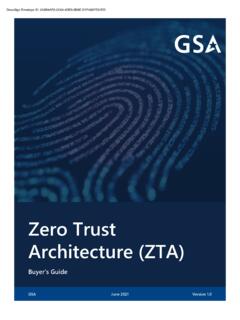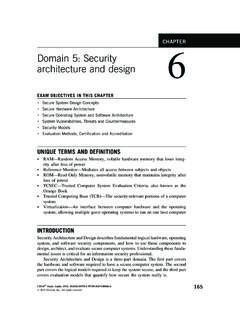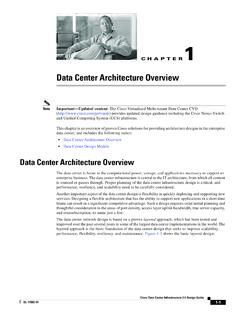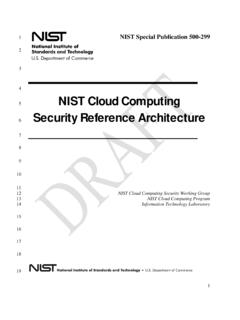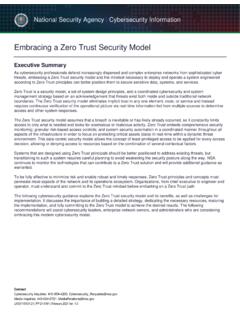Transcription of Security test plan template - SaM-Solutions US
1 Copyright 2014. SaM Solutions Security Test plan template SaM Solutions GmbH & Co. KG Am Bahnhof 4a 82205, Glinting Germany Tel.: +49 81 057 7890 Fax: +49 81 057 78920 Copyright 2014. SaM Solutions Contents REVISION HISTORY 3 ..1. DOCUMENT GOALS 4 ..2. TARGET AUDIENCE 4 ..3. PROJECT DESCRIPTION 4 ..4. GLOSSARY 4 ..5. TESTING OBJECTIVES 5 ..6. ROLES AND RESPONSIBILITIES 5 ..7. METHODOLOGY 5 .. (DEPENDENCY TESTING) 6 .. SIDE TESTING 6 .. DESIGN VULNERABILITIES (DESIGN TESTING) 6 .. IMPLEMENTATION VULNERABILITIES (IMPLEMENTATION TESTING) 6 ..8. SCOPE OF TESTING 6 .. TO BE TESTED 6 .. NOT TO BE TESTED 7 ..9. ASSUMPTIONS FOR TEST EXECUTION 7.
2 10. TEST COMPLETION CRITERIA 7 ..11. TESTING STRATEGY 7 .. AND USE CASES PHASE 7 .. policies and standards 7 .. measurement and metrics criteria 8 .. requirements analysis 8 .. PHASE 8 .. design and architecture 8 .. and review UML models 8 .. and review threat tree 9 .. PHASE 9 .. analysis 9 .. testing 9 ..12. TEST RESULTS 10 ..13. TOOLSET 10 ..14. LIST OF DELIVERABLES 11 ..APPENDIX A. TOOLSET Solutions GmbH & Co. KG Am Bahnhof 4a 82205, Glinting Germany Tel.: +49 81 057 7890 Fax: +49 81 057 78920 Security Test plan TemplateVersion: Date: Oct 28, 2014 Copyright 2014. SaM Solutions Revision History RevisonChangesContributorDateSaM Solutions GmbH & Co.
3 KG Am Bahnhof 4a 82205, Glinting Germany Tel.: +49 81 057 7890 Fax: +49 81 057 78920 Copyright 2014. SaM Solutions 1. Document Goals This test plan is designed to: -describe the approach used by the test group during testing; -organize and implement the testing process; -define the test deliverables; 2. Target Audience Target audience is the Customer s representatives, SaM s management staff, software engineers and software testing team. 3. Project Description Place the description of your project here. 4. Glossary Defect (Bug) nonconformance of the product to the functional/non-functional requirements of the specification. Bug Tracking System a system for storing, processing and tracking defects through their lifecycle.
4 Test case a set of inputs, execution conditions, and expected outcomes developed for a particular objective, such as to exercise a particular program path or to verify compliance with a specific requirement. Audit - a review of a system in order to validate it. Generally, this either refers to code auditing or reviewing audit logs. Authentication a process of verifying identity, ownership, and/or authorization. Authorization guarantees that an authenticated user has the appropriate rights to access a definite entity of the application. Risk - a possibility of a negative or undesirable occurrence. There are two independent parts of risk: impact and likelihood.
5 Impact - describes the negative effect that results from a risk being realized. Likelihood - describes the chance that a risk will be realized and the negative impact will occur. Threat a potential event that will have unwanted consequence if it becomes an attack. Vulnerability a flaw or weakness in a system, such as coding bug or design flaw that can compromise the system s Security . Attack occurs when an attacker has a motive and takes advantage. SaM Solutions GmbH & Co. KG Am Bahnhof 4a 82205, Glinting Germany Tel.: +49 81 057 7890 Fax: +49 81 057 78920 Security Test plan TemplateVersion: Date: Oct 28, 2014 Copyright 2014.
6 SaM Solutions 5. Testing Objectives The objective of Security testing of the product is to: define Security goals through understanding Security requirements of the applications; identify the Security threats; validate that the Security controls operate as expected; eliminate the impact of Security issues on the safety and integrity of the product; guarantee that the product will function correctly under malicious attacks; 6. Roles and responsibilities The team members will be performing the following roles: 7. Methodology All the testing process is built on the basis of the following Security attacks classes: RoleResponsibilitiesContact informationTe a m L e a d Test process setting up and adjusting Security test plan creation Test strategy authoring Test activities tracking Giving conclusion about the Designer Security models creation Test cases and test suites creation and Engineer Running test cases Defects authoring Test results analysis Test reports Solutions GmbH & Co.
7 KG Am Bahnhof 4a 82205, Glinting Germany Tel.: +49 81 057 7890 Fax: +49 81 057 78920 Copyright 2014. SaM Solutions (dependency testing) The dependency type of testing supposes that the 3-rd part modules (or libraries, code, etc.) are tested. During this procedure a test engineer verifies whether: An application has vulnerabilities of (3-rd part) components it uses; Modules that provide Security services fail; There are Security vulnerabilities in the file system; There are Security vulnerabilities in the registry. side testing During this type of testing a test engineer works with the user interface exclusively. He/she tries to enter incorrect input sequences, like: Escape characters; Long strings; Parts of some code in a programming language; Incorrect input values; Testing for error handling; Perform cross site scripting.
8 Design vulnerabilities (design testing) The design vulnerabilities can be caused by an immature design or development process. On this stage the next issues are controlled: Open unsecured ports; Insecure default values and accounts; Debug code intertwined with implementation code; implementation vulnerabilities (implementation testing) This type of vulnerabilities may occur because of implementation errors: Developers who develop only their modules could unintentionally reveal data: for example, incorrect validation; Time-of-check-to-time-of-use issues. 8. Scope of Testing to be tested Name the features/modules to be tested SaM Solutions GmbH & Co.
9 KG Am Bahnhof 4a 82205, Glinting Germany Tel.: +49 81 057 7890 Fax: +49 81 057 78920 Copyright 2014. SaM Solutions not to be tested Name the features/modules not to be tested 9. Assumptions for Test Execution Before starting to test the following conditions should be met: The test environment is ready and configured appropriately. The version has been launched on the test environment and the version notification has been sent to a QA Team Lead. In the built notification all the features planned for the build are claimed to be ready. Smoke tests have been passed successfully (all the test cases have the Passed status). If one of the above mentioned items is not fulfilled the QA Team Lead returns the build to the development team for correction.
10 10. Test Completion Criteria In case all the conditions that are indicated below are performed the testing process supposed to be finished: All test cases planned for the current build have been run (except blocked ones). All the found defects have been posted to the bug tracking system. A test result report has been sent to all interested parties. A conclusion on the quality of the version has been done. 11. Testing Strategy The strategy of Security testing is built-in in the software development lifecycle (SDLC) of the application and consists of the following phases: and use cases phase policies and standards On this stage a test engineer makes sure that there are appropriate policies, standards, and documentation in place.
